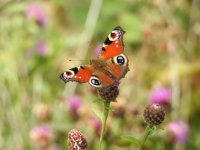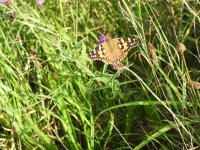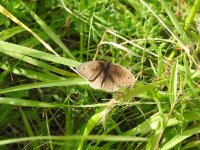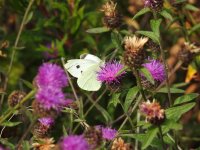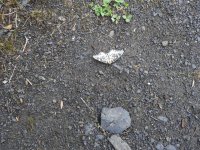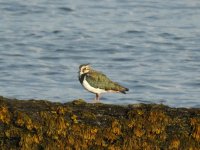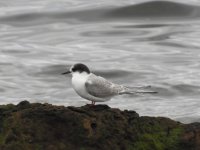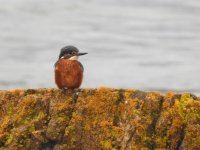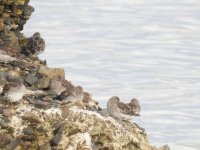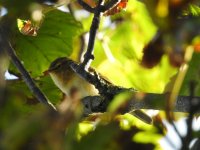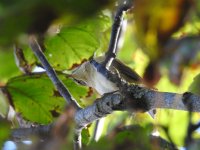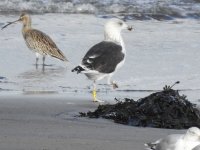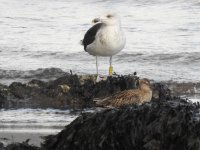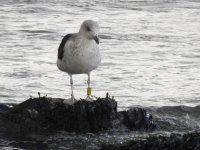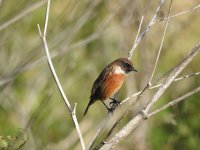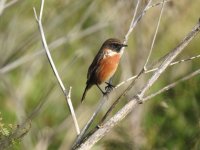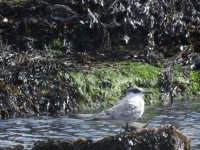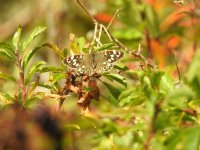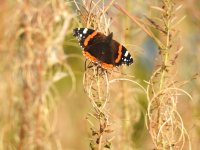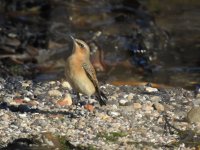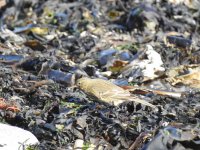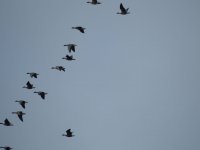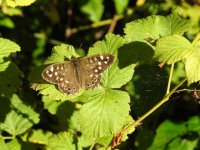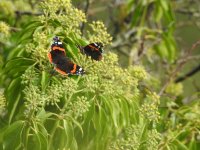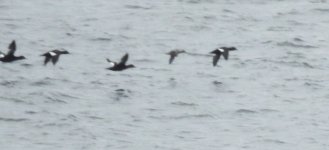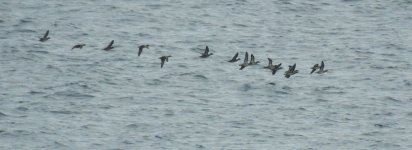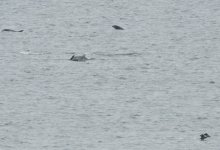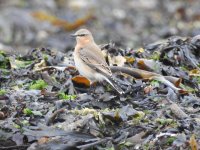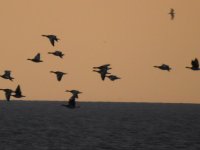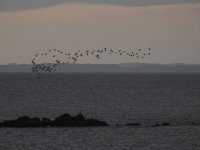-
Welcome to BirdForum, the internet's largest birding community with thousands of members from all over the world. The forums are dedicated to wild birds, birding, binoculars and equipment and all that goes with it.
Please register for an account to take part in the discussions in the forum, post your pictures in the gallery and more.
You are using an out of date browser. It may not display this or other websites correctly.
You should upgrade or use an alternative browser.
You should upgrade or use an alternative browser.
Seafield to Kinghorn (2 Viewers)
- Thread starter Gander
- Start date
More options
Who Replied?New Tick For Ninety
A late afternoon walk was more in hope than expectation, however, hope won through. Approaching the tower, I found a lone bird out on one of the rocks, that is the ninetieth species recorded for the strip. I thought I'd seen one fly off back in the spring, from nearly the exact same location, but was not sure. No mistaking the Lapwing this time.
There were two Mallard near the Lapwing, but more unusually, there were a further thirty just past the tower. Kingfisher also seen just past the tower.
THE LIST UPDATED
1. Bar-tailed Godwit
2. Blackcap
3. Black-headed Gull
4. Black-tailed Godwit
5. Blackbird
6. Blue Tit
7. Bullfinch
8. Carrion Crow
9. Chaffinch
10. Chiffchaff
11. Collared Dove
12. Common Buzzard
13. Common Gull
14. Common Sandpiper
15. Common Scoter*
16. Common Tern
17. Cormorant
18. Curlew
19. Dunlin
20. Dunnock
21. Eider
22. Feral Pigeon
23. Fulmar
24. Gannet
25. Garden Warbler
26. Goldcrest
27. Goldeneye
28. Goldfinch
29. Goosander
30. Great Black-backed Gull
31. Great Crested Grebe
32. Great Tit
33. Greenfinch
34. Greenshank
35. Grey Heron
36. Greylag
37. Grey Wagtail
38. Guillemot
39. Herring Gull
40. Housemartin
41. House Sparrow
42. Kestrel
43. Kingfisher
44. Knot
45. Lapwing
46. Lesser Black-backed Gull
47. Linnet
48. Long-tailed Duck
49. Long-tailed Tit
50. Magpie
51. Mallard
52. Meadow Pipit
53. Mute Swan
54. Oystercatcher
55. Pheasant
56. Pied Wagtail (Yarrellii)
57. Pink-Footed Goose
58. Peregrine
59. Puffin
60. Purple Sandpiper
61. Raven*
62. Red-Throated Diver*
63. Red-breasted Merganser
64. Redshank
65. Reed Bunting
66. Ringed Plover
67. Robin
68. Rock Pipit
69. Ruff
70. Sanderling
71. Sandwich Tern
72. Sedge Warbler
73. Shag
74. Skylark
75. Song Thrush
76. Sparrowhawk
77. Starling
78. Stonechat*
79. Swallow
80. Swift
81. Teal
82. Turnstone
83. Velvet Scoter
84. Wheatear
85. Whimbrel
86. Whitethroat
87. Willow Warbler
88. Woodpigeon
89. Wren.
90. Yellowhammer
A late afternoon walk was more in hope than expectation, however, hope won through. Approaching the tower, I found a lone bird out on one of the rocks, that is the ninetieth species recorded for the strip. I thought I'd seen one fly off back in the spring, from nearly the exact same location, but was not sure. No mistaking the Lapwing this time.
There were two Mallard near the Lapwing, but more unusually, there were a further thirty just past the tower. Kingfisher also seen just past the tower.
THE LIST UPDATED
1. Bar-tailed Godwit
2. Blackcap
3. Black-headed Gull
4. Black-tailed Godwit
5. Blackbird
6. Blue Tit
7. Bullfinch
8. Carrion Crow
9. Chaffinch
10. Chiffchaff
11. Collared Dove
12. Common Buzzard
13. Common Gull
14. Common Sandpiper
15. Common Scoter*
16. Common Tern
17. Cormorant
18. Curlew
19. Dunlin
20. Dunnock
21. Eider
22. Feral Pigeon
23. Fulmar
24. Gannet
25. Garden Warbler
26. Goldcrest
27. Goldeneye
28. Goldfinch
29. Goosander
30. Great Black-backed Gull
31. Great Crested Grebe
32. Great Tit
33. Greenfinch
34. Greenshank
35. Grey Heron
36. Greylag
37. Grey Wagtail
38. Guillemot
39. Herring Gull
40. Housemartin
41. House Sparrow
42. Kestrel
43. Kingfisher
44. Knot
45. Lapwing
46. Lesser Black-backed Gull
47. Linnet
48. Long-tailed Duck
49. Long-tailed Tit
50. Magpie
51. Mallard
52. Meadow Pipit
53. Mute Swan
54. Oystercatcher
55. Pheasant
56. Pied Wagtail (Yarrellii)
57. Pink-Footed Goose
58. Peregrine
59. Puffin
60. Purple Sandpiper
61. Raven*
62. Red-Throated Diver*
63. Red-breasted Merganser
64. Redshank
65. Reed Bunting
66. Ringed Plover
67. Robin
68. Rock Pipit
69. Ruff
70. Sanderling
71. Sandwich Tern
72. Sedge Warbler
73. Shag
74. Skylark
75. Song Thrush
76. Sparrowhawk
77. Starling
78. Stonechat*
79. Swallow
80. Swift
81. Teal
82. Turnstone
83. Velvet Scoter
84. Wheatear
85. Whimbrel
86. Whitethroat
87. Willow Warbler
88. Woodpigeon
89. Wren.
90. Yellowhammer
Attachments
Last edited:
Cuckoo-shrike
Well-known member
Keep your eye out for skuas. I had one Pom, 2 Arctic and 2 Bonxies off Kinghorn from 1700-1800hrs today.
Keep your eye out for skuas. I had one Pom, 2 Arctic and 2 Bonxies off Kinghorn from 1700-1800hrs today.
I'll certainly do that. I was in Kinghorn this morning. Found a little car park at Pettycur Bay that looked like a good viewing point. Where do you normally view from?
Late Arctic and old friends
I had pretty much given up on getting an Arctic Tern along the strip this year, but this afternoon, I was pleasantly surprised by a young one on the rocks at the tower. Second patch tick this week can't be bad, even though things still feel a little sluggish down there.
Some old friends have also turned up in the harbour, as the first Purple Sandpipers have moved in for the winter. And I again found my resident Kingfisher posing in the sunshine.
I was stopped on the path by a family with young children. The mum was asking about the Cormorants out on the rocks, but the kids were thrilled when I showed them the the just taken shots of the Kingfisher. They couldn't wait to go looking for it themselves. :t:
THE LIST UPDATED
1. Arctic Tern
2. Bar-tailed Godwit
3. Blackcap
4. Black-headed Gull
5. Black-tailed Godwit
6. Blackbird
7. Blue Tit
8. Bullfinch
9. Carrion Crow
10. Chaffinch
11. Chiffchaff
12. Collared Dove
13. Common Buzzard
14. Common Gull
15. Common Sandpiper
16. Common Scoter*
17. Common Tern
18. Cormorant
19. Curlew
20. Dunlin
21. Dunnock
22. Eider
23. Feral Pigeon
24. Fulmar
25. Gannet
26. Garden Warbler
27. Goldcrest
28. Goldeneye
29. Goldfinch
30. Goosander
31. Great Black-backed Gull
32. Great Crested Grebe
33. Great Tit
34. Greenfinch
35. Greenshank
36. Grey Heron
37. Greylag
38. Grey Wagtail
39. Guillemot
40. Herring Gull
41. Housemartin
42. House Sparrow
43. Kestrel
44. Kingfisher
45. Knot
46. Lapwing
47. Lesser Black-backed Gull
48. Linnet
49. Long-tailed Duck
50. Long-tailed Tit
51. Magpie
52. Mallard
53. Meadow Pipit
54. Mute Swan
55. Oystercatcher
56. Pheasant
57. Pied Wagtail (Yarrellii)
58. Pink-Footed Goose
59. Peregrine
60. Puffin
61. Purple Sandpiper
62. Raven*
63. Red-Throated Diver*
64. Red-breasted Merganser
65. Redshank
66. Reed Bunting
67. Ringed Plover
68. Robin
69. Rock Pipit
70. Ruff
71. Sanderling
72. Sandwich Tern
73. Sedge Warbler
74. Shag
75. Skylark
76. Song Thrush
77. Sparrowhawk
78. Starling
79. Stonechat*
80. Swallow
81. Swift
82. Teal
83. Turnstone
84. Velvet Scoter
85. Wheatear
86. Whimbrel
87. Whitethroat
88. Willow Warbler
89. Woodpigeon
90. Wren.
91. Yellowhammer
I had pretty much given up on getting an Arctic Tern along the strip this year, but this afternoon, I was pleasantly surprised by a young one on the rocks at the tower. Second patch tick this week can't be bad, even though things still feel a little sluggish down there.
Some old friends have also turned up in the harbour, as the first Purple Sandpipers have moved in for the winter. And I again found my resident Kingfisher posing in the sunshine.
I was stopped on the path by a family with young children. The mum was asking about the Cormorants out on the rocks, but the kids were thrilled when I showed them the the just taken shots of the Kingfisher. They couldn't wait to go looking for it themselves. :t:
THE LIST UPDATED
1. Arctic Tern
2. Bar-tailed Godwit
3. Blackcap
4. Black-headed Gull
5. Black-tailed Godwit
6. Blackbird
7. Blue Tit
8. Bullfinch
9. Carrion Crow
10. Chaffinch
11. Chiffchaff
12. Collared Dove
13. Common Buzzard
14. Common Gull
15. Common Sandpiper
16. Common Scoter*
17. Common Tern
18. Cormorant
19. Curlew
20. Dunlin
21. Dunnock
22. Eider
23. Feral Pigeon
24. Fulmar
25. Gannet
26. Garden Warbler
27. Goldcrest
28. Goldeneye
29. Goldfinch
30. Goosander
31. Great Black-backed Gull
32. Great Crested Grebe
33. Great Tit
34. Greenfinch
35. Greenshank
36. Grey Heron
37. Greylag
38. Grey Wagtail
39. Guillemot
40. Herring Gull
41. Housemartin
42. House Sparrow
43. Kestrel
44. Kingfisher
45. Knot
46. Lapwing
47. Lesser Black-backed Gull
48. Linnet
49. Long-tailed Duck
50. Long-tailed Tit
51. Magpie
52. Mallard
53. Meadow Pipit
54. Mute Swan
55. Oystercatcher
56. Pheasant
57. Pied Wagtail (Yarrellii)
58. Pink-Footed Goose
59. Peregrine
60. Puffin
61. Purple Sandpiper
62. Raven*
63. Red-Throated Diver*
64. Red-breasted Merganser
65. Redshank
66. Reed Bunting
67. Ringed Plover
68. Robin
69. Rock Pipit
70. Ruff
71. Sanderling
72. Sandwich Tern
73. Sedge Warbler
74. Shag
75. Skylark
76. Song Thrush
77. Sparrowhawk
78. Starling
79. Stonechat*
80. Swallow
81. Swift
82. Teal
83. Turnstone
84. Velvet Scoter
85. Wheatear
86. Whimbrel
87. Whitethroat
88. Willow Warbler
89. Woodpigeon
90. Wren.
91. Yellowhammer
Attachments
Last edited:
One week on.
A week has passed since my last report. One week on, with all sorts of birds arriving in many and diverse places, I can report the results of several lengthy visits along the strip, monitoring the influx of migratory birds as being ......................drum roll...................
One Chiffchaff.
It was a very nice Chiffchaff though!
Who needs all those rarities and star birds when you've got a really nice Chiffchaff?
A week has passed since my last report. One week on, with all sorts of birds arriving in many and diverse places, I can report the results of several lengthy visits along the strip, monitoring the influx of migratory birds as being ......................drum roll...................
One Chiffchaff.
It was a very nice Chiffchaff though!
Who needs all those rarities and star birds when you've got a really nice Chiffchaff?
Attachments
Tagged Gull
No change on the strip this afternoon, other than a noted increase in Yellowhammer numbers. I was hoping, once again, for Skuas, but once again, I got nothing.
On the way back to the car park, I did spot a bird with a difference. A tagged Great Black-Backed Gull. I believe it to be from a NE Scotland project. I await feedback from the tagger, whom I have contacted.
I could do with a few more birds from the NE of Scotland taking this gull's example, and heading to the Seafield Strip. That Red-Backed Shrike would do nicely for a start. :t: 3 :-O
:-O
No change on the strip this afternoon, other than a noted increase in Yellowhammer numbers. I was hoping, once again, for Skuas, but once again, I got nothing.
On the way back to the car park, I did spot a bird with a difference. A tagged Great Black-Backed Gull. I believe it to be from a NE Scotland project. I await feedback from the tagger, whom I have contacted.
I could do with a few more birds from the NE of Scotland taking this gull's example, and heading to the Seafield Strip. That Red-Backed Shrike would do nicely for a start. :t: 3
Attachments
Magazine Report
I have just been reading the October edition of "Bird Watching" magazine. In the August sightings section I read that twenty-six Manx Shearwater went past Seafield on the 6th, and three Arctic Skuas went past on the 13th.
Happy to add these birds to the list, but hugely frustrated that I haven't personally seen a Shearwater or Skua from Seafield. At least I know what's possible. I just need to be there at the right time. :t:
THE LIST UPDATED
1. Arctic Skua*
2. Arctic Tern
3. Bar-tailed Godwit
4. Blackcap
5. Black-headed Gull
6. Black-tailed Godwit
7. Blackbird
8. Blue Tit
9. Bullfinch
10. Carrion Crow
11. Chaffinch
12. Chiffchaff
13. Collared Dove
14. Common Buzzard
15. Common Gull
16. Common Sandpiper
17. Common Scoter*
18. Common Tern
19. Cormorant
20. Curlew
21. Dunlin
22. Dunnock
23. Eider
24. Feral Pigeon
25. Fulmar
26. Gannet
27. Garden Warbler
28. Goldcrest
29. Goldeneye
30. Goldfinch
31. Goosander
32. Great Black-backed Gull
33. Great Crested Grebe
34. Great Tit
35. Greenfinch
36. Greenshank
37. Grey Heron
38. Greylag
39. Grey Wagtail
40. Guillemot
41. Herring Gull
42. Housemartin
43. House Sparrow
44. Kestrel
45. Kingfisher
46. Knot
47. Lapwing
48. Lesser Black-backed Gull
49. Linnet
50. Long-tailed Duck
51. Long-tailed Tit
52. Magpie
53. Mallard
54. Manx Shearwater*
55. Meadow Pipit
56. Mute Swan
57. Oystercatcher
58. Pheasant
59. Pied Wagtail (Yarrellii)
60. Pink-Footed Goose
61. Peregrine
62. Puffin
63. Purple Sandpiper
64. Raven*
65. Red-Throated Diver*
66. Red-breasted Merganser
67. Redshank
68. Reed Bunting
69. Ringed Plover
70. Robin
71. Rock Pipit
72. Ruff
73. Sanderling
74. Sandwich Tern
75. Sedge Warbler
76. Shag
77. Skylark
78. Song Thrush
79. Sparrowhawk
80. Starling
81. Stonechat*
82. Swallow
83. Swift
84. Teal
85. Turnstone
86. Velvet Scoter
87. Wheatear
88. Whimbrel
89. Whitethroat
90. Willow Warbler
91. Woodpigeon
92. Wren.
93. Yellowhammer
I have just been reading the October edition of "Bird Watching" magazine. In the August sightings section I read that twenty-six Manx Shearwater went past Seafield on the 6th, and three Arctic Skuas went past on the 13th.
Happy to add these birds to the list, but hugely frustrated that I haven't personally seen a Shearwater or Skua from Seafield. At least I know what's possible. I just need to be there at the right time. :t:
THE LIST UPDATED
1. Arctic Skua*
2. Arctic Tern
3. Bar-tailed Godwit
4. Blackcap
5. Black-headed Gull
6. Black-tailed Godwit
7. Blackbird
8. Blue Tit
9. Bullfinch
10. Carrion Crow
11. Chaffinch
12. Chiffchaff
13. Collared Dove
14. Common Buzzard
15. Common Gull
16. Common Sandpiper
17. Common Scoter*
18. Common Tern
19. Cormorant
20. Curlew
21. Dunlin
22. Dunnock
23. Eider
24. Feral Pigeon
25. Fulmar
26. Gannet
27. Garden Warbler
28. Goldcrest
29. Goldeneye
30. Goldfinch
31. Goosander
32. Great Black-backed Gull
33. Great Crested Grebe
34. Great Tit
35. Greenfinch
36. Greenshank
37. Grey Heron
38. Greylag
39. Grey Wagtail
40. Guillemot
41. Herring Gull
42. Housemartin
43. House Sparrow
44. Kestrel
45. Kingfisher
46. Knot
47. Lapwing
48. Lesser Black-backed Gull
49. Linnet
50. Long-tailed Duck
51. Long-tailed Tit
52. Magpie
53. Mallard
54. Manx Shearwater*
55. Meadow Pipit
56. Mute Swan
57. Oystercatcher
58. Pheasant
59. Pied Wagtail (Yarrellii)
60. Pink-Footed Goose
61. Peregrine
62. Puffin
63. Purple Sandpiper
64. Raven*
65. Red-Throated Diver*
66. Red-breasted Merganser
67. Redshank
68. Reed Bunting
69. Ringed Plover
70. Robin
71. Rock Pipit
72. Ruff
73. Sanderling
74. Sandwich Tern
75. Sedge Warbler
76. Shag
77. Skylark
78. Song Thrush
79. Sparrowhawk
80. Starling
81. Stonechat*
82. Swallow
83. Swift
84. Teal
85. Turnstone
86. Velvet Scoter
87. Wheatear
88. Whimbrel
89. Whitethroat
90. Willow Warbler
91. Woodpigeon
92. Wren.
93. Yellowhammer
Corvus cornix
Well-known member
Happy to add these birds to the list, but hugely frustrated that I haven't personally seen a Shearwater or Skua from Seafield. At least I know what's possible. I just need to be there at the right time. :t:
I'm sure you'll pick them up soon. What do you think are the chances of getting the 100 before the end of the year?
Keep up the good work with the thread! :t:
Cheers
Farnboro John
Well-known member
I'm sure you'll pick them up soon. What do you think are the chances of getting the 100 before the end of the year?
Keep up the good work with the thread! :t:
Cheers
Work out the most likely seven and go after them relentlessly :t:
John
What do you think are the chances of getting the 100 before the end of the year?
I think it is possible, but I probably need a few unexpected visitors. Wildfowl is an area where there is a bit of potential. There are quite a few fairly common ducks, geese and swans that would not be a surprise, such as Tufted, Scaup, Barnacle, Whooper.
There are a lot of potential waders also. Curlew Sand and Little Stint for example should not be impossible.
My biggest disappointment has been the lack of small migratory birds in the scrub. The place is absolutely loaded with berries such as Hawthorn, Blackthorn, Elderberry, Bramble, Buckthorn, Rosehip and Rowan, but it has thus far attracted very little passing trade, so to speak. To be honest, I think I am a little too far up the Forth to be on the main route. Being able to clearly see the Isle of May, makes that a bitter pill to swallow, but I am going to keep chipping away.
Historically, there have been a few really good spots along the strip. Too far in the past for me to just list, but sightings of Black Redstart and King Eider are a tantalising reminder that anything is possible.
And of course, new ticks are very welcome, but I am still thoroughly enjoying the presence of many of my more regular birds.
Work out the most likely seven and go after them relentlessly :t:
John
I think Scaup, Tufted Duck, Great Northern Diver, Black-Throated Diver, Black-Throated Grebe, Red-Throated Grebe and Mediterranean Gull.
All are sighted quite often in the areas either side of Seafield. Looks like I should be concentrating on sea watching then.:t:
A Personal Chat.
Following a night of yet more heavy rain from the west, I arrived this morning to a sunny and calm Seafield. The dog walkers were out in force on the exposed sands, so I hurried along to the tower, where things usually get a bit quieter.
Just past the tower, the numbers of Reed Bunting are growing. Up to the stone dyke, there was nothing out of the interest, but as soon as I dropped down onto the back of Bullfinch Cove, I found three Bullfinches. It is the first time I have seen them here for a while. In fact, I have been toying with the idea of changing the name I use for the cove to something more geographical. Now however, it is settled as Bullfinch Cove, unless of course I ever find out that it has a local historical name.
At the back of Lime Kiln beach, there was a fair bit of activity in the scrub with Willow Warblers/Chiffchaff, Blue Tits, Robins, Blackbirds, Goldfinch, Wren and Yellowhammer. There were also Goldcrest. One of them had me pretty excited for a moment, as when I first viewed it, it was having a good old raking scratch of its head. As it did so, a fiery orange stripe was seen in the middle of the gold head stripe. Once the bird straightened up however, the orange disappeared below the gold, and it revealed itself to be a Goldcrest, and not the Firecrest I was willing it to be.
I turned back at the top of the Lime Kiln Rise, and nothing out of the ordinary was seen on my return journey until I started to make my down the slope that drops down to the tower. As I descended on the path, up popped a bird in the grasses to one side. The binoculars revealed it to be a favourite of mine, but a personal patch tick in the shape of a Stonechat. I rushed to pull the camera out for a record shot, but the rush was not needed, as within minutes of spotting the first bird, I had at least four of them flitting about.
Only other thing of note after the tower was a lone Sandwich Tern out on the rocks. I haven't seen any for over a week, and this one seems to have a ring on it (see photo).
A good day on the strip. Nothing exceptional, but any day I get Bullfinch and Stonechat is a good day.:t:
Following a night of yet more heavy rain from the west, I arrived this morning to a sunny and calm Seafield. The dog walkers were out in force on the exposed sands, so I hurried along to the tower, where things usually get a bit quieter.
Just past the tower, the numbers of Reed Bunting are growing. Up to the stone dyke, there was nothing out of the interest, but as soon as I dropped down onto the back of Bullfinch Cove, I found three Bullfinches. It is the first time I have seen them here for a while. In fact, I have been toying with the idea of changing the name I use for the cove to something more geographical. Now however, it is settled as Bullfinch Cove, unless of course I ever find out that it has a local historical name.
At the back of Lime Kiln beach, there was a fair bit of activity in the scrub with Willow Warblers/Chiffchaff, Blue Tits, Robins, Blackbirds, Goldfinch, Wren and Yellowhammer. There were also Goldcrest. One of them had me pretty excited for a moment, as when I first viewed it, it was having a good old raking scratch of its head. As it did so, a fiery orange stripe was seen in the middle of the gold head stripe. Once the bird straightened up however, the orange disappeared below the gold, and it revealed itself to be a Goldcrest, and not the Firecrest I was willing it to be.
I turned back at the top of the Lime Kiln Rise, and nothing out of the ordinary was seen on my return journey until I started to make my down the slope that drops down to the tower. As I descended on the path, up popped a bird in the grasses to one side. The binoculars revealed it to be a favourite of mine, but a personal patch tick in the shape of a Stonechat. I rushed to pull the camera out for a record shot, but the rush was not needed, as within minutes of spotting the first bird, I had at least four of them flitting about.
Only other thing of note after the tower was a lone Sandwich Tern out on the rocks. I haven't seen any for over a week, and this one seems to have a ring on it (see photo).
A good day on the strip. Nothing exceptional, but any day I get Bullfinch and Stonechat is a good day.:t:
Attachments
Last edited:
New Species
Morning walk along the strip revealed a new species at the back of Lime Kiln Beach. Not a bird, but a butterfly. The strip has a healthy population of Red Admirals at the moment, but my eye was drawn to something a little different that landed in the scrub close to the path. It was not a butterfly that I recognised, so I scrambled for the camera and got a few pictures as the subject sunned itself.
Back at home, I've done a little research and found that my butterfly is a Speckled Wood. I can't find a record of a population in Fife, but there is one across the water in Lothian. It doesn't seem to be a common butterfly in Scotland though, outside of small localised populations.
On the bird front, L-T Tits have made an appearance and I also found a couple of Blackcaps. The Blackcaps are difficult to get a view of as they seem to be one of the more furtive birds I have found here. Also pleased to say that at least one of the Stonechats has remained on location, and is hanging out with the Reed Buntings on the grassy slope south of the tower.
Morning walk along the strip revealed a new species at the back of Lime Kiln Beach. Not a bird, but a butterfly. The strip has a healthy population of Red Admirals at the moment, but my eye was drawn to something a little different that landed in the scrub close to the path. It was not a butterfly that I recognised, so I scrambled for the camera and got a few pictures as the subject sunned itself.
Back at home, I've done a little research and found that my butterfly is a Speckled Wood. I can't find a record of a population in Fife, but there is one across the water in Lothian. It doesn't seem to be a common butterfly in Scotland though, outside of small localised populations.
On the bird front, L-T Tits have made an appearance and I also found a couple of Blackcaps. The Blackcaps are difficult to get a view of as they seem to be one of the more furtive birds I have found here. Also pleased to say that at least one of the Stonechats has remained on location, and is hanging out with the Reed Buntings on the grassy slope south of the tower.
Attachments
Rock Pipits
I had a good session along the strip this afternoon, despite the increased traffic along the path caused by a sunny Saturday afternoon. The scrub was a little quieter, with no sign of some of the regulars that I've been seeing all week. Wren, Blackbird, Yellowhammer, Reed Bunting and even Stonechat were all notable by their sudden absence, or more likely reticence.
In their stead however, I had a three new arrivals. Most notable were a small flock of a dozen Rock Pipits. At the time of sighting, I thought they were all Meadow Pipits, but have gone through the photos I grabbed, and having posted them on the Bird ID section of this forum, I am happy to say that they were all Rock Pipits. In amongst them, I also found a couple of Wheatears. I have to say that I absolutely love Wheatears.
The last new arrival spotted were two Greenfinch seen deep in a Hawthorn bush. There have been far fewer Greenfinch along the strip than there were last year, so I'm happy to see a couple more representatives.
Other highlights were a Blackcap, also deep in a Hawthorn fortress and a flock of one hundred plus Pink-Footed Geese that passed over. Also, a second Speckled Wood was seen, giving me hope that I have the start of a local population here.
I had a good session along the strip this afternoon, despite the increased traffic along the path caused by a sunny Saturday afternoon. The scrub was a little quieter, with no sign of some of the regulars that I've been seeing all week. Wren, Blackbird, Yellowhammer, Reed Bunting and even Stonechat were all notable by their sudden absence, or more likely reticence.
In their stead however, I had a three new arrivals. Most notable were a small flock of a dozen Rock Pipits. At the time of sighting, I thought they were all Meadow Pipits, but have gone through the photos I grabbed, and having posted them on the Bird ID section of this forum, I am happy to say that they were all Rock Pipits. In amongst them, I also found a couple of Wheatears. I have to say that I absolutely love Wheatears.
The last new arrival spotted were two Greenfinch seen deep in a Hawthorn bush. There have been far fewer Greenfinch along the strip than there were last year, so I'm happy to see a couple more representatives.
Other highlights were a Blackcap, also deep in a Hawthorn fortress and a flock of one hundred plus Pink-Footed Geese that passed over. Also, a second Speckled Wood was seen, giving me hope that I have the start of a local population here.
Attachments
I made a last walk along the strip this afternoon before I head offshore for three weeks tomorrow. I was accompanied by my youngest, who definitely has a growing interest.
Bird activity was very low, however, we did find a Blackcap that was a first for my son, and on the return journey, we also found him his first ever Wheatear.
Kingfisher was also present and Dolphins seen out in the FoF.
P.S - Just been sorting out the photos from this afternoon (with a bit of help) and found that I had caught a shot of a very distant four Velvet Scoter with a bunch of Teal.
Also, one of the dolphin photos seems to show a calf on an adults back.
Bird activity was very low, however, we did find a Blackcap that was a first for my son, and on the return journey, we also found him his first ever Wheatear.
Kingfisher was also present and Dolphins seen out in the FoF.
P.S - Just been sorting out the photos from this afternoon (with a bit of help) and found that I had caught a shot of a very distant four Velvet Scoter with a bunch of Teal.
Also, one of the dolphin photos seems to show a calf on an adults back.
Attachments
Last edited:
Stonefaction
Dundee Birding....(target 150 in 2024).

Paul, worth emailing the local butterfly recorder for Fife with your Speckled Wood sighting as one I found last year at Kilminning was only the second record for Fife at the time. Know there has been one or two this year, but I reckon they'd be happy to hear of your sighting.
Paul, worth emailing the local butterfly recorder for Fife with your Speckled Wood sighting as one I found last year at Kilminning was only the second record for Fife at the time. Know there has been one or two this year, but I reckon they'd be happy to hear of your sighting.
I have recorded both my sightings with Butterfly Conservation. They have been running a Speckled Wood survey in Scotland for a few years. I didn't realise there will be a butterfly recorder for Fife, so I'll look him/her up to make sure they get the info.
Unfinished Business
Yesterday's afternoon visit along the strip had been partially prompted by reports of large numbers of Barnacle Geese being on the move in Fife. I found no geese yesterday, but waking early this morning, I decided break of dawn was my best chance to see Barnacles on the move, so I headed for Seafield.
I was between the harbour and the tower when I spotted a flock of geese out over the water, winging their way east in the general direction of Largo Bay. You'd think I'd have learnt to have the camera ready by now, but I hadn't, so it was the usual scramble to get it out of the bag and focused onto the distant flock. Although they were distant, I felt that by the way they were flying, that they were not the currently default Pink-Foots. Now, having looked at the shots on the computer screen, I'm as sure as I can be that Barnacle Goose has just made the list.
A nice final tick for this leave. Now it's time to pack my bag and head north. Wonder if I can find a few Barnacles offshore. :t:
Yesterday's afternoon visit along the strip had been partially prompted by reports of large numbers of Barnacle Geese being on the move in Fife. I found no geese yesterday, but waking early this morning, I decided break of dawn was my best chance to see Barnacles on the move, so I headed for Seafield.
I was between the harbour and the tower when I spotted a flock of geese out over the water, winging their way east in the general direction of Largo Bay. You'd think I'd have learnt to have the camera ready by now, but I hadn't, so it was the usual scramble to get it out of the bag and focused onto the distant flock. Although they were distant, I felt that by the way they were flying, that they were not the currently default Pink-Foots. Now, having looked at the shots on the computer screen, I'm as sure as I can be that Barnacle Goose has just made the list.
A nice final tick for this leave. Now it's time to pack my bag and head north. Wonder if I can find a few Barnacles offshore. :t:
Attachments
Users who are viewing this thread
Total: 3 (members: 0, guests: 3)




